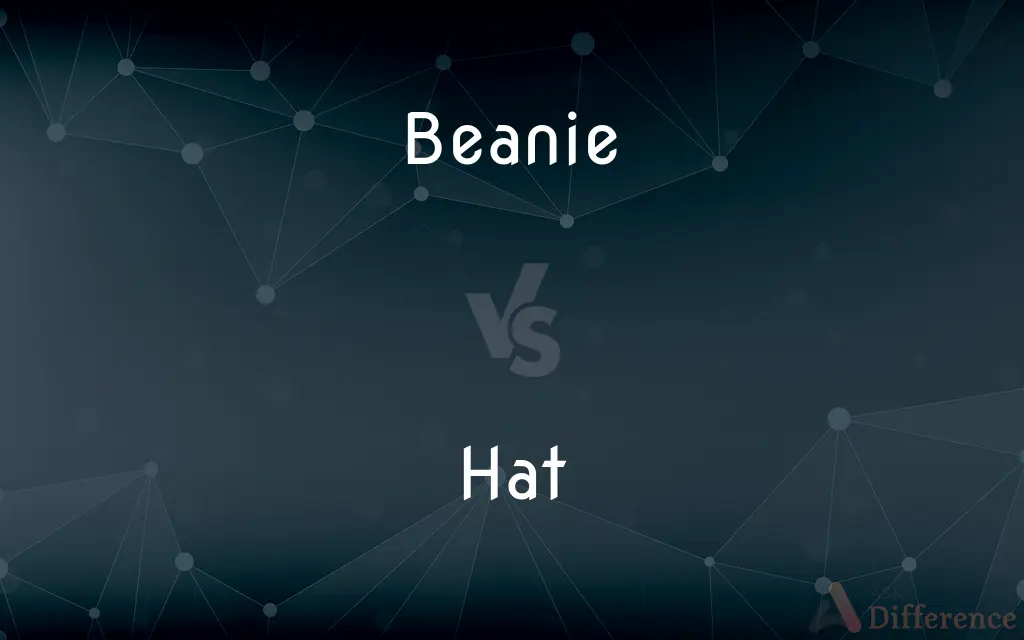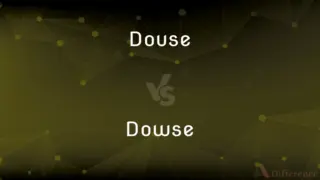Beanie vs. Hat — What's the Difference?
Edited by Tayyaba Rehman — By Urooj Arif — Updated on April 21, 2024
A beanie is a close-fitting, knitted cap worn for warmth, typically without a brim, whereas a hat encompasses a variety of headgear styles, often featuring brims and decorative elements.

Difference Between Beanie and Hat
Table of Contents
ADVERTISEMENT
Key Differences
A beanie is designed to provide warmth by fitting snugly around the head, typically made from wool or synthetic materials. Whereas hats can be made from a variety of materials including straw, felt, leather, or fabric, depending on their function and style.
Beanies are often worn in colder climates or during winter to cover the ears and head fully, providing insulation. On the other hand, hats can be functional or fashionable accessories, suitable for various climates and occasions, from sun protection to formal wear.
The design of beanies is generally simple and stretchy, accommodating most head sizes without adjustments. In contrast, hats may come in various shapes and sizes, often requiring specific sizing to ensure a proper fit.
Beanies typically lack brims, focusing on warmth and simplicity. Meanwhile, many hats feature brims of various sizes, from narrow to wide, which serve to protect the face and neck from sun and rain.
In fashion contexts, beanies are considered casual and are commonly associated with youthful, sporty, or urban styles. Whereas hats can range from casual to formal, enhancing outfits in diverse ways such as fedoras, bowlers, and cowboy hats.
ADVERTISEMENT
Comparison Chart
Material
Wool, synthetic
Straw, felt, leather, fabric
Climate
Cold
All climates, varies with style
Function
Warmth, simple protection
Sun protection, fashion, formal wear
Design Features
Close-fitting, no brim, stretchy
May have brims, structured, variable sizes
Style Context
Casual, sporty, youthful
Ranges from casual to formal
Compare with Definitions
Beanie
Associated with casual and urban fashion styles.
He added a beanie to his outfit for a more laid-back look.
Hat
A covering for the head that often includes a brim and is available in various shapes and sizes.
She chose a wide-brimmed hat for her day at the beach.
Beanie
A soft, close-fitting knitted cap worn on the head.
He wore a red beanie to keep warm during the ski trip.
Hat
Used for both functional purposes such as protection from the elements and as a fashion accessory.
She wore a floppy hat to shield her face from the sun.
Beanie
Typically used in cold weather or winter sports.
All the players wore matching beanies for the winter tournament.
Hat
Comes in many forms, including fedoras, baseball caps, and berets.
He collects vintage fedoras, each hat telling a story of a past era.
Beanie
Often made without a brim and designed to provide warmth.
Her beanie was so snug that it covered her ears completely.
Hat
Often requires sizing to fit properly.
He had his hat custom-sized to ensure a perfect fit.
Beanie
Can be made from wool or synthetic materials.
She prefers beanies made from natural wool because they are warmer.
Hat
Can be made from materials like straw, felt, or leather.
His favorite hat is a leather cowboy hat that he wears to outdoor concerts.
Beanie
A snug, knitted, brimless cap that usually covers the ears.
Hat
A hat is a head covering which is worn for various reasons, including protection against weather conditions, ceremonial reasons such as university graduation, religious reasons, safety, or as a fashion accessory.In the past, hats were an indicator of social status. In the military, hats may denote nationality, branch of service, rank or regiment.
Beanie
A small brimless cap.
Hat
A covering for the head, especially one with a shaped crown and brim.
Beanie
A cap that fits the head closely, usually knitted from wool.
Hat
A head covering of distinctive color and shape worn as a symbol of office.
Beanie
A head-hugging brimless cap, with or without a visor, made from triangular sections of cloth, leather, or silk joined by a button at the crown and seamed together around the sides.
Hat
The office symbolized by the wearing of such a head covering.
Beanie
(informal) A Beanie Baby, a small soft toy filled with beans or similar stuffing.
Hat
A role or office symbolized by or as if by the wearing of different hats
Wears two hats—one as parent and one as corporate executive.
Beanie
A small skullcap; formerly worn by schoolboys and college freshmen.
Hat
To supply or cover with a hat.
Beanie
A small skullcap; formerly worn by schoolboys and college freshmen
Hat
A covering for the head, often in the approximate form of a cone, dome or cylinder closed at its top end, and sometimes having a brim and other decoration.
Hat
(figuratively) A particular role or capacity that a person might fill.
Hat
(figuratively) Any receptacle from which numbers/names are pulled out in a lottery.
Hat
The lottery or draw itself.
We're both in the hat: let's hope we come up against each other.
Hat
(video games) A hat switch.
Hat
The háček symbol.
Hat
The caret symbol ^.
Hat
(internet slang) User rights on a website, such as the right to edit pages others cannot.
Hat
A student who is also the son of a nobleman (and so allowed to wear a hat instead of a mortarboard).
Hat
(transitive) To place a hat on.
Hat
(transitive) To appoint as cardinal.
Hat
(intransitive) To shop for hats.
Hat
Hot.
Hat
A covering for the head; esp., one with a crown and brim, made of various materials, and worn by men or women for protecting the head from the sun or weather, or for ornament.
Hat
Headdress that protects the head from bad weather; has shaped crown and usually a brim
Hat
An informal term for a person's role;
He took off his politician's hat and talked frankly
Hat
Put on or wear a hat;
He was unsuitably hatted
Hat
Furnish with a hat
Common Curiosities
Is a beanie considered formal wear?
Beanies are not typically considered formal wear; they are more casual or sporty.
What defines a hat?
A hat is any of various styles of head covering, often designed with a brim and worn for protective or fashion purposes.
Can a hat have protective features?
Yes, many hats, such as sun hats and hard hats, have features like brims or reinforced materials for protection.
What is a beanie?
A beanie is a close-fitting, brimless cap typically knitted, designed to keep the head warm.
What is the main function of a hat?
The main function can vary but generally includes protection from the elements or enhancement of an outfit.
Are beanies suitable for summer?
Beanies are generally not suitable for summer as they are designed for warmth.
Do hats offer UV protection?
Yes, hats with brims, especially those made from UV-blocking materials, offer UV protection.
Can beanies fit all head sizes?
Beanies are stretchy and designed to fit most head sizes comfortably.
Which is better for formal events, a beanie or a hat?
Hats, depending on the style, are typically more appropriate for formal events than beanies.
What is the most popular type of hat for casual wear?
Baseball caps are among the most popular types of hats for casual wear.
Are hats a part of uniform attire?
In many professions, hats are part of the uniform, such as in military or police uniforms.
What materials are beanies made from?
Beanies are commonly made from materials like wool or acrylic.
Can hats be adjusted for size?
Some hats come with adjustable features like straps or bands, while others must be sized precisely.
Are there waterproof beanies?
Yes, some beanies are made with waterproof materials for outdoor sports.
How do I choose the right hat for outdoor activities?
Consider the weather conditions, activity type, and whether features like a wide brim or ventilation are needed.
Share Your Discovery

Previous Comparison
Comedy vs. Drama
Next Comparison
Douse vs. DowseAuthor Spotlight
Written by
Urooj ArifUrooj is a skilled content writer at Ask Difference, known for her exceptional ability to simplify complex topics into engaging and informative content. With a passion for research and a flair for clear, concise writing, she consistently delivers articles that resonate with our diverse audience.
Edited by
Tayyaba RehmanTayyaba Rehman is a distinguished writer, currently serving as a primary contributor to askdifference.com. As a researcher in semantics and etymology, Tayyaba's passion for the complexity of languages and their distinctions has found a perfect home on the platform. Tayyaba delves into the intricacies of language, distinguishing between commonly confused words and phrases, thereby providing clarity for readers worldwide.
















































